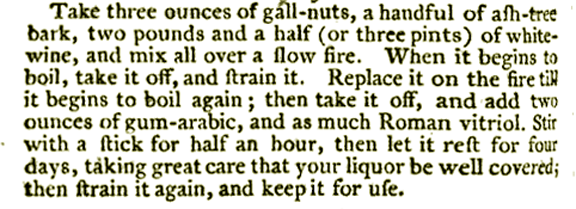
Found this unattributed picture on Pinterest but Marty claims it:
Marty Vint, www.MartyQuilts.com
Maria Fulford signed her cut-out chintz album block
with the date "Sep. 1845" and a Bible verse.
It looks like she inked a series of tiny dots rather than strokes.
When I wrote Clues in the Calico my guide to dating antique quilts in 1979, I dated the invention of a non-corrosive inks specifically for textiles to the mid-1830s, based on advertising claims made in the 1890s for Payson’s Indelible Ink.
Payson's from Northampton, Massachusetts, marketed their product as “the oldest and best ink for marking linen, silk and cotton with a common pen without preparation. Payson’s has been a household word for over 65 years."
I went on to credit non-corrosive ink as contributing “to the fad for autograph quilts, which developed soon after Payson’s was invented.”
I have since changed my mind, primarily due to a 1992 article in AQSG's Uncoverings by textile scientist Dr. Margaret T. Ordoñez who gave quilt historians necessary insight into chemical processes in old inks. (Margaret T. Ordonez's "Ink Damage on Nineteenth-Century Cotton Signature Quilts," Uncoverings, Volume 13)
The large dark areas here are holes in the cotton caused by the ink.
Ordoñez’s research into ink composition indicates that there is no such clear-cut date for non-corrosive, commercial inks. She notes “the search for permanent inks that did not damage paper and fabric was ongoing throughout the nineteenth and into the twentieth century.”
An old recipe for nutgall or iron gall ink.
Before the mid-19th century, most permanent inks for paper or fabric were made from nutgalls (small growths in oak trees caused by gall wasps depositing their eggs) combined with water and ferrous sulfate. A plant gum was often added.
The ink appeared pale brown when initially applied, but a chemical reaction, an oxidation, darkened the color and turned it permanent over time, usually just a few days. Varied recipes, particularly the proportions of nutgall and iron, could result in ink that changed again over time to a rusty brown.
Ink on the 19th-century quilts Ordoñez studied appeared to be shades of yellowish-brown or reddish brown to black. The acids in these “iron gallotannate” inks and the continuing oxidation have a tendency to rot cellulosic fabrics, linen and cotton, something Ordoñez noted with her microscope and that quilt collectors too often see with the naked eye.
The ink also corrodes silk. This one said Centennial Year.
The ink was just as corrosive to paper.
This album quilt has a signature along the bottom
that shows the bleeding we see in paper and cloth.
It would appear that the nut gall and iron inks were generally homemade according to widely available recipes. Ordoñez also describes a second type of traditional ink, an India ink or permanent carbon ink. The carbon inks, made with lampblack and other soot, also could be formulated by an amateur chemist at home. Both types were manufactured for sale.
Another problem with the nut gall inks is they fade from light.
Whenever I buy an inked quilt I photograph the signatures immediately
because I have had them completely disappear over time.
My whole cause-and-effect argument about a change in ink chemistry in the 1830s affecting the look of American quilts in the early 1840s seems very dubious in light of the evidence. There isn't much difference between the ink being used in 1640, 1840 or 1880.
See a tutorial on making nut gall ink from the Rhode Island School of Design site:






















Very interesting. Something I never gave much thought to before. Thanks for sharing.
ReplyDeleteI would have never thought about that, and I have seen quilts with holes in them. I use an archival ink on my things, wonder how it will look in 100 years;)
ReplyDeleteDebbie
Thanks for everything you share, I am found of quilt history, and I always found very interesting to read you.
ReplyDeleteMerci beaucoup!
Maxame
Interesting. I thought the whole rationale for teaching cross stitch to young ladies in women's academies was so they could mark their linens and I've read that the developmentvof a reliable permanent ink brought about the end of the schoolgirl cross stitch embroidered sampler. Perhaps that's not true either!
ReplyDeleteYour advise about taking pix of any inked work on quilts is a really good one. I have a signature quilt from about 1865. Most of the blocks are still legible but the one containing the date has faded to nothing! Perhaps the extra handling of that block over time due to the commemerative note on it contributed to it's fading?! Also a lot of the blocks are stamped with personal stamps. These seem to be much worse off than the hand written blocks. Perhaps due to mechanical damage when the ink was pressed into the cloth? It's still a lovely quilt. Peoples hand writing was so beautiful back then it is still a very interesting quilt to look at and study! cheers.
ReplyDeleteClaire--the writing may fade from light or just a chemical reaction over time.
ReplyDeleteI should do a post on the personal stamps.Same ink though.
Barbara, you used my photo of the Maria Fulford block and should have credited my website as well as received permission. Marty Vint, www.MartyQuilts.com
ReplyDelete